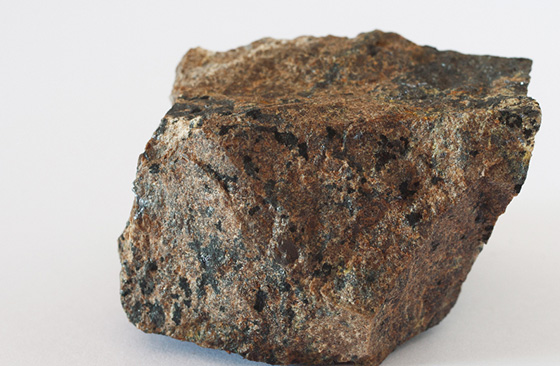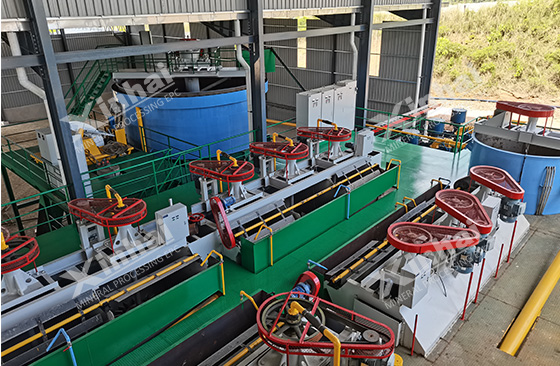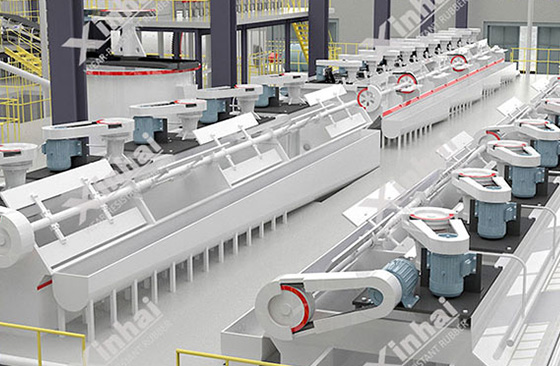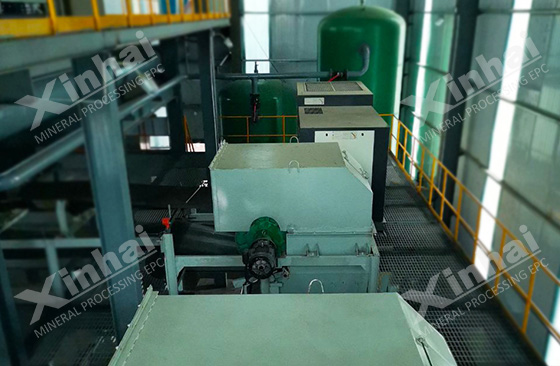Copper-molybdenum ore, as one of the main sources of molybdenum resources, the amount of recyclable molybdenum accounts for 48% of the world's total molybdenum. Copper-molybdenum ore is mainly copper as the main associated mineral, often in the form of porphyry copper ore. Due to the low grade of raw ore and fine particle size of embedded distribution in such deposits, preferential flotation and mixed flotation are used in principle in the separation of copper and molybdenum ore, and mixed flotation is mostly used. Because the separation of copper and molybdenum ore in copper-molybdenum concentrate is difficult, some pretreatment is required before the separation of copper and molybdenum. The following will introduce the pretreatment process and separation process before the separation of copper-molybdenum ore.

Use the table of contents below to navigate through the guide:
01Pretreatment process of copper molybdenum ore
Copper-molybdenum ore is generally pretreated before the separation of copper-molybdenum ore by physical or chemical methods, which can be divided into three types: concentration and drug removal, heat treatment and oxidation.
1. Concentration and drug removal: The foam product obtained by mixed flotation of copper-molybdenum ore contains a large amount of xanthic acid collectors. These residual chemicals affect the floatability of chalcopyrite and increase the dosage of inhibitors. In order to solve this problem, concentration and removal of chemicals are carried out before the separation of copper and molybdenum.
2. Heat treatment: The heat treatment before the separation of copper and molybdenum is to decompose, oxidize or evaporate the hydrophobic film of the collector adsorbed on the mineral surface. Oxidation occurs on the surface of non-molybdenum sulfide minerals, and its flotation is inhibited. In actual production, the use of hot water heating during the separation of copper and molybdenum concentrate can significantly improve the quality and recovery rate of molybdenum concentrate and reduce the amount of sodium sulfide.
3. Oxidation treatment: Before the copper-molybdenum concentrate is separated, in order to suppress copper minerals, strong oxidants such as chlorine, hydrogen peroxide, and odor will be added to the pulp to oxidize and decompose the collector on the surface of copper sulfide, and the surface of copper minerals will also A hydrophilic oxide adsorption layer is formed in alkaline solution.
The above are three pretreatment methods before the separation of copper-molybdenum concentrate, and the specific selection should be based on the beneficiation process of copper-molybdenum ore.

02Separation method of copper molybdenum ore
After pretreatment, the copper-molybdenum mixed concentrate needs to be separated. The commonly used separation methods are as follows:
1. Conventional flotation method: general concentrators will adopt the process of inhibiting copper minerals to flotation molybdenum concentrates. The key to this process is to inhibit copper minerals. Inorganic substances can be used as agents to inhibit copper sulfide, such as sodium sulfide, Knox and cyanide. These several inorganic substances can be used alone or mixed in proportion. The agent for inhibiting copper sulfide can also use organic substances such as thioglycolate and ethyl mercaptan. After the copper minerals are suppressed, a small amount of non-polar oil is added to the flotation of molybdenum concentrate to strengthen the flotation effect of molybdenite. Regulators such as water glass can also be added to the pulp to suppress gangue minerals, disperse the pulp, and improve the grade of molybdenum concentrate. Molybdenum concentrates with higher grades can be obtained after repeated beneficiation.

2. Nitrogen-filling flotation method: Since cyanide and other inhibitors have certain harmful effects on the environment, these toxic agents are gradually eliminated, and the concentrator will use sodium sulfide, sodium hydrosulfide and other sulfides as copper sulfide inhibitors . Because sodium sulfide has a strong reducing property, it is easily oxidized by dissolved oxygen or other oxides in the pulp, which will increase the amount of sulfide. The use of nitrogen-filled flotation can reduce the dosage of these inhibitors, and the flotation effect is the same as that of air-filled flotation.
3. Pulsating high-gradient magnetic separation method: This method is an effective way to separate weak magnetic minerals, and is widely used in the separation of useful minerals such as weak magnetic iron ore, manganese ore and wolframite. Since chalcopyrite is a weak magnetic mineral and molybdenite is a nonmagnetic mineral, this magnetic separation method can also be used for the separation of copper and molybdenum concentrates.

4. Passivation treatment process: During passivation treatment, the surface of copper minerals in the mixed concentrate will become hydrophobic due to oxidation, or the xanthate on the surface of copper minerals and in the pulp will decompose, and the oxidation will fail. Xanthate is prone to failure under conditions such as acidity, high temperature, and long time. When the pH value ranges from 10 to 11, chalcopyrite can be oxidized into SO42- and S2O32- plasma. At this time, the floatability of chalcopyrite decreases and it is easy to oxidize in the air.
The above content is the pretreatment method and separation method of copper molybdenum ore. Due to the variety of separation technologies for copper-molybdenum ore, the specific separation process should be customized according to the characteristics of the ore and the quality requirements of the final product. Xinhai Mining recommends mineral beneficiation test analysis in order to determine the appropriate mineral processing plan and improve the utilization rate of resources.


 marketing@ytxinhai.com
marketing@ytxinhai.com  0086 13810327080
0086 13810327080 






































































































 CHAT
CHAT MESSAGE
MESSAGE






